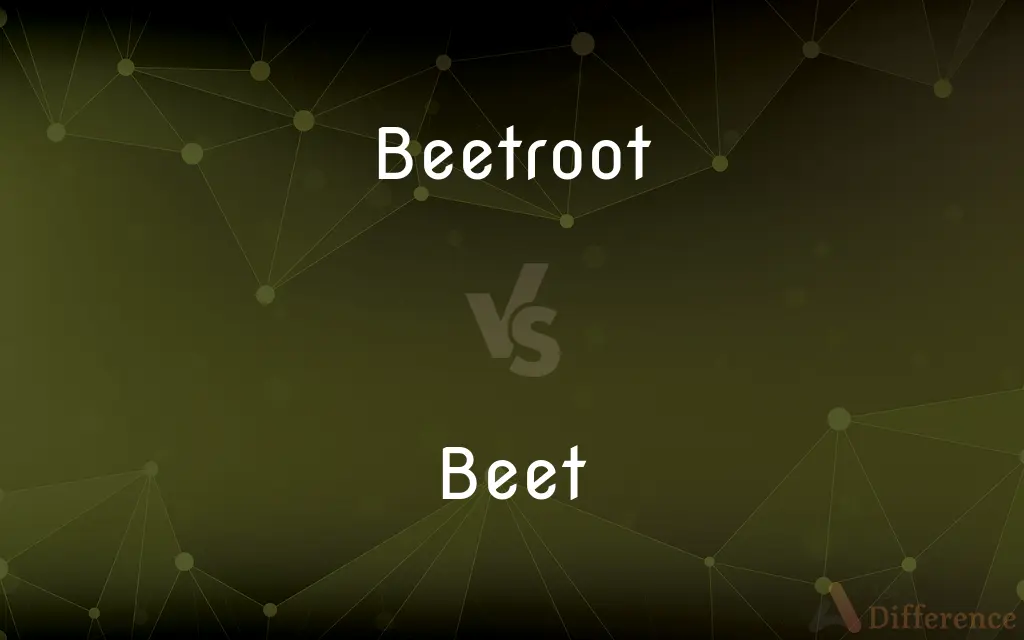Beetroot vs. Beet — What's the Difference?
By Tayyaba Rehman — Updated on September 4, 2023
Beetroot refers specifically to the edible, dark-red root of the beet plant, while Beet encompasses the entire plant, including its leaves and root. Both are nutritious and edible.

Difference Between Beetroot and Beet
Table of Contents
ADVERTISEMENT
Key Differences
Beetroot is the term specifically pointing to the dark-red or purple root of the beet plant that's often consumed boiled, roasted, or raw. This root is known for its deep color and is packed with vitamins, minerals, and antioxidants. Beet, on the other hand, refers to the entire plant, encompassing both the root and the green leafy top.
In many cuisines, beetroot is a popular ingredient for salads, juices, or even cooked dishes. Its distinct color often serves to make dishes visually appealing. The beet, however, offers versatility. While the root can be consumed in similar ways to the beetroot, its leaves, often referred to as beet greens, can be cooked and consumed much like spinach or chard.
In terms of nutritional benefits, beetroot offers a rich source of fiber, folic acid, manganese, and potassium. Beet, being a broader term, signifies the combined health benefits of both its root and the leaves. The leaves of the beet plant are rich in calcium, iron, and vitamins A and C.
A slight difference in regional usage can also be observed. In British English, the term 'beetroot' is more commonly used, even when referring to just the root. In contrast, American English typically favors the term 'beet' to denote the root. Despite these differences, both words highlight a vegetable known for its health benefits and diverse culinary uses.
Comparison Chart
Part of the Plant
Root of the beet plant.
Entire plant, including root and leaves.
ADVERTISEMENT
Common Usage
Eaten boiled, roasted, or raw.
Root is eaten, leaves (beet greens) are cooked.
Nutritional Emphasis
Fiber, folic acid, manganese, potassium.
Root's nutrients + calcium, iron from leaves.
Regional Preference
More common in British English.
More common in American English for the root.
Culinary Versatility
Used in salads, juices, dishes for color.
Both root and leaves used in various dishes.
Compare with Definitions
Beetroot
The edible dark-red root of the beet plant.
She added slices of beetroot to her salad for color.
Beet
A plant with a red or white bulbous root and green leaves.
I pulled a beet from the garden to use in tonight's dinner.
Beetroot
A root known for its distinct deep color.
Beetroot stain is hard to get out of white fabric.
Beet
The entire beet plant, used in cooking and salads.
She sautéed the beet greens and roasted the root for a complete meal.
Beetroot
A common ingredient in various dishes.
Beetroot soup, also known as borscht, is popular in many Eastern European countries.
Beet
A source of various nutrients, including vitamins and minerals.
Eating beets regularly can be beneficial for your health.
Beetroot
A vegetable often consumed for its health benefits.
Drinking beetroot juice can help lower blood pressure.
Beet
A plant known for its earthy taste and rich color.
He made a beet smoothie for breakfast.
Beetroot
The underground portion of the beet plant.
The beetroot has been harvested, but the greens are still fresh.
Beet
A vegetable encompassing both its root and leaves.
We grow beets in our backyard every summer.
Beetroot
The beetroot is the taproot portion of a beet plant, usually known in Canada and the USA as beets while the vegetable is referred to as beetroot in British English, and also known as the table beet, garden beet, red beet, dinner beet or golden beet. It is one of several cultivated varieties of Beta vulgaris grown for their edible taproots and leaves (called beet greens); they have been classified as B. vulgaris subsp.
Beet
A biennial Eurasian plant (Beta vulgaris) grown as a crop plant for its edible roots and leaves.
Beetroot
The edible dark red spherical root of a kind of beet, eaten as a vegetable.
Beet
The swollen root of this plant eaten as a vegetable, typically having reddish flesh.
Beetroot
The variety of beet which produces beetroots.
Beet
The sugar beet.
Beetroot
The edible root of the beet.
Beet
Beta vulgaris, a plant with a swollen root which is eaten or used to make sugar.
The beet is a hardy species.
There are beets growing over these.
Beetroot
A normally deep-red-coloured root vegetable usually cooked or pickled before eating; beet.
Beet
A beetroot, a swollen root of such a plant.
Beetroot
The edible part of the root of a beet plant, raw or prepared.
Beet
To improve; to mend.
Beetroot
To turn a bright red or purple colour.
Beet
To kindle a fire.
Beetroot
Beet having a massively swollen red root; widely grown for human consumption
Beet
To rouse.
Beetroot
Round red root vegetable
Beet
A biennial plant of the genus Beta, which produces an edible root the first year and seed the second year.
Beet
The root of plants of the genus Beta, different species and varieties of which are used for the table, for feeding stock, or in making sugar.
Beet
Biennial Eurasian plant usually having a swollen edible root; widely cultivated as a food crop
Beet
Round red root vegetable
Common Curiosities
Is beetroot good for health?
Absolutely, beetroot is packed with vitamins, minerals, and antioxidants.
Which term is more common in American English?
In American English, "beet" is commonly used to refer to the root.
Can you eat the entire beet plant?
Yes, both the root and the green leafy tops are edible.
What is beetroot?
Beetroot refers to the dark-red root of the beet plant.
How is 'beet' different from 'beetroot'?
Beet refers to the entire plant, while beetroot specifies the root.
Can beetroot stain clothes?
Yes, beetroot has a deep color that can stain fabrics.
What are the benefits of eating beet greens?
Beet greens are rich in calcium, iron, and vitamins A and C.
Are there different varieties of beets?
Yes, there are multiple varieties, including sugar beets and golden beets.
Are beet greens similar to any other greens?
Beet greens can be similar in taste and texture to spinach or chard.
How can you store beets?
Beets can be stored in a cool, dry place or refrigerated.
Do beets taste earthy?
Yes, beets have a unique, earthy flavor.
Do beetroot and beet have similar nutritional profiles?
While they share many nutrients, beetroot focuses on root benefits, and beet encompasses both root and leaf nutrients.
Is beetroot juice good for athletes?
Many athletes consume beetroot juice for its potential to improve performance.
Are beets used in desserts?
Yes, beets can be used in certain desserts, like beetroot chocolate cake.
Which part of the beet plant is most commonly eaten?
While both parts are edible, the root is more commonly consumed.
Share Your Discovery

Previous Comparison
Thnx vs. Thx
Next Comparison
Vein vs. VenuleAuthor Spotlight
Written by
Tayyaba RehmanTayyaba Rehman is a distinguished writer, currently serving as a primary contributor to askdifference.com. As a researcher in semantics and etymology, Tayyaba's passion for the complexity of languages and their distinctions has found a perfect home on the platform. Tayyaba delves into the intricacies of language, distinguishing between commonly confused words and phrases, thereby providing clarity for readers worldwide.














































